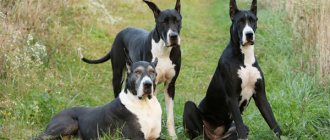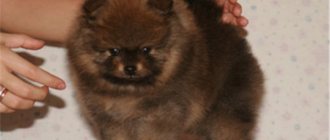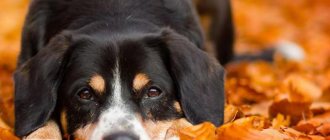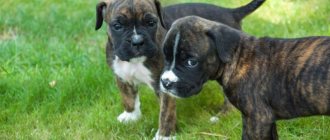German boxer - an amazing dog. Having a warlike appearance, she is very loyal to people. In terms of good nature, dogs of this breed will give odds to many other dog breeds.
Dogs of this breed are very active , playful and curious . They retain these qualities throughout their lives. This should be taken into account by a person who decides to purchase a puppy of this breed. After all, to properly raise a dog you will have to put in a lot of effort.
In addition, the owner will have to walk the dog a lot. A boxer needs such walks to maintain good physical shape .
History of the origin of the breed
The German Boxer breed has existed for more than two thousand years. Their ancestors were the now extinct baiting dogs - Bullenbeissers. Their name speaks for itself; translated from German it means “bull biter”. The dogs had powerful jaws with a pincer-like bite. This allowed them to breathe fully while clinging to their prey. Dogs were used in hunting big game: wild boars, deer, bears.
After the ban on the pickling method of extraction, the specialized breed lost its relevance. Its representatives began to be crossed with English bulldogs, and the resulting individuals were used by cattle breeders to protect their herds. Some dog experts believe that German shepherds also participated in the selection process.
The final prototype of the modern boxer was bred in 1850, 45 years later the first exhibition took place in Munich, the establishment of a German boxer fan club, with official recognition of the breed.
Why the new dog received such a name is not known exactly. According to the most common version, it is based on the dog’s ability to use its front paws in a fight. According to other assumptions, the name is based on the appearance of the animal, whose muzzle resembles a boxing glove.
Gradually, active, inquisitive dogs spread throughout the world. In 1950, an international club for boxers appeared - ATIBOX, which included representatives of several dozen countries. Today the breed is very popular in America, but is less common in Russia.
Historical reference
The Boxer is the result of crossing English Mastiffs with Bullenbeisers. Based on these data, we can conclude that the roots of the breed go back to the period BC.
The ancient Romans and Greeks bred military Molossians from Tibetan Great Danes. Later they spread to northern and central Europe. There, breeders mixed mastiff hybrids into English mastiffs. At the same time, Bullenbeissers, small, brave dogs for guarding livestock, hunting and baiting large wild animals, were popular in Germany.
Bullenbeiser - one of the ancestors of the German boxer
It is impossible to track the exact moment of the appearance of the familiar breed. The first identical images date back to the end of the 19th century. Munich resident Georg Alt conducted experiments on mating brindle bullenbeisers with mastiffs and dogs of unknown origin. In one of the litters a fawn-white male appeared - the first representative of the modern German boxer. Abilities for discipline, intelligence, high endurance and healthy aggression quickly made the dog attractive for serving people. In 1894, three of Alt's followers set about stabilizing the new cross. The first nursery was opened in 1895. In 1904, the American Kennel Club adopted an official standard.
The etymology of the name of the breed is not precisely established. According to the first version, it was tied to the similarity of the muzzle to a boxing glove and the characteristic movements of the front paws in battle. According to the second assumption, the word "Boxer" was borrowed by Europeans by accident and was originally used in Germany to refer to all dogs in general.
Description of the breed with photos
The German Boxer gives the impression of a strong, hardy dog with well-developed, prominent muscles.
The breed standard stipulates the following characteristics:
- the body is square in shape, with strong bones;
- the head is quite large, but proportional to the body;
- the neck is strong, not too long;
- shortened muzzle with pronounced jowls;
- the eyes are dark and should not be bulging or sunken;
- the nose is large, pigmented black (dark brown is acceptable);
- The triangular ears are set high and close to the muzzle;
- a snack is required;
- limbs are straight, with developed muscles;
- The tail is straight and set high.
Please note: In some countries, ear and tail docking are prohibited by the 2002 German Boxer breed standard.
In addition to the officially recognized German breed variety, cynologists informally distinguish its American type. This includes the descendants of individuals who were transported overseas after the Second World War. They differ from the German ones in their more graceful physique and smaller head size. But these differences are noticeable only to experienced experts.
Indicators such as a head disproportionate to the body (too small or large), open teeth with a closed mouth, an unclear mask on the muzzle, and apathetic movements are recognized as a breed defect.
Size and weight
The German Boxer is a medium-sized dog. According to the standard, height at the withers is:
- 57-64 cm – for males;
- 53-63 cm – for females.
Females are more graceful, their weight rarely reaches 30 kg, ideally females weigh 25-27 kg. Males are more massive; for them, the permissible body weight is set at 27 - 35 kg.
Color and coat type
The coat of the German Boxer is thin, short, with a characteristic shine, and fits tightly to the body.
There are two officially recognized colors: red and brindle, within which many shades are acceptable (from pale yellow to brick brown).
The brindle color suggests the presence of dark, clearly drawn contrasting stripes on the main background. This coat color is the most common; it perfectly emphasizes the dog’s muscular structure.
White spots in a Boxer's color are acceptable, but they should not occupy more than 1/3 of the total surface area of the body. If this ratio is violated, the dog will be disqualified. Sometimes albino puppies are born in a litter, but they are recognized as a breed defect.
Uses [edit]
Boxer on a boat in Lake Lanier, South Carolina.
Boxers are friendly, lively companions and popular as family dogs. [4] Their suspicion of strangers, alertness, agility, and strength make them formidable guard dogs. They sometimes appear in agility or canine obedience competitions, and in flyball competitions. These strong and intelligent animals have also been used as service dogs, guide dogs for the blind, therapy dogs, police dogs in K9 units, and occasionally herding cattle or sheep. The Boxer's versatility was recognized early on by the military, who used them as valuable messenger dogs, pack dogs, and war and guard dogs during war.
Health and illness
Boxers are not known for their good health. The list of pathologies to which they are predisposed is very extensive. Hearing problems are common in this breed. According to statistics, from 20 to 40% of puppies are born completely or partially deaf.
Other breed-specific diseases include:
- allergy;
- aortic stenosis;
- brachiocephalic syndrome;
- bloating;
- hip dysplasia;
- cardiomyopathy;
- hypothyroidism;
- gastrointestinal pathologies;
- conjunctivitis;
- demodicosis;
- entropion of the eyelid;
- dermatitis (including allergic);
- deforming spondylosis.
Caution: Boxers are prone to developing malignant tumors.
The risks of developing pathologies can be minimized with the help of a well-designed diet and annual examinations by a veterinarian, which make it possible to timely identify and stop the development of “breed” diseases.
Lifespan
The average life expectancy of a boxer is short - about 10 years . But in recent years, experts have noted an increase in the number of individuals surviving up to fifteen years of age. This is due to the fact that breeders and veterinarians are actively working to improve the health of the breed.
Vaccination helps protect against deadly diseases. The first comprehensive vaccination (against distemper, parainfluenza, adenovirus, parvovirus enteritis, leptospirosis) is given to a Boxer puppy at the age of eight weeks. At 12-13 weeks, revaccination is carried out, and they are also vaccinated against rabies. The pet is then vaccinated annually. Before the procedure, the dog must be completely healthy; deworming must be carried out a couple of weeks before the procedure.
Temperament[edit]
The character of a boxer is of great importance and requires the closest attention. He has long been known for his great love and loyalty to his master and family. He is harmless in the family, but can be distrustful of strangers, intelligent and friendly in games, but brave and determined when excited. His intelligence and amenability, modesty and cleanliness make him a very desirable family dog and cheerful companion. He is the soul of honesty and loyalty, and is never deceitful or treacherous even in old age.
- 1938 AKC Boxer Breed Standard
[22]
Boxers are a bright, energetic and playful breed, and they tend to get along very well with children. [4] They are patient and energetic with children, but also nurturing, making them a popular choice for families. [4] They are active, strong dogs that require adequate exercise to prevent boredom-related behaviors such as chewing, digging, or licking. Boxers have developed a slight reputation for being "stubborn", which may be due to improper obedience training. Due to their intelligence and working breed characteristics, training based on corrections is often of limited usefulness. Boxers, like other animals, generally respond better to positive reinforcement techniques such as clicker training, an approach based on operant conditioning and behaviorism, which gives the dog the ability to think independently and solve problems. [23] [24] Based on a survey of obedience trainers by Stanley Coren, summarized in his book The Intelligence of Dogs
, Boxers ranked 48th - Average Working/Docile Intelligence. Many who have worked with boxers strongly disagree with the results of Coren's survey and argue that an experienced trainer using reward-based methods will find boxers to be well above average in intelligence and performance. [23] [24] [25]
The Boxer is not an inherently aggressive or angry breed. It is an instinctive caretaker and can become very attached to its family. Like all dogs, it requires proper socialization. [26] [ need better source
] Boxers are usually patient with small dogs and puppies, but may have difficulty with larger adult dogs, especially dogs of the same sex. Boxers tend to be more comfortable socializing in both their human and canine forms. They are very patient and can be used as family dogs because they get along well with children and people of all types.
- Tiger boxer head
- Head of a brindle boxer with white neck
- Fawn boxer puppy
- Boxer fawn head
Character and intelligence
The German boxer has a stable psyche, an easy-going disposition, and a lively temperament. He loves all family members and is friendly and calm at home. The dog splashes out all its energy on walks. These dogs are very curious, they will happily go on a long journey, they will sniff every inch of the ground, looking for something interesting. At the same time, boxers do not run far from their owner. They love to spend time with their family.
Representatives of this breed are very cunning and good psychologists. They will instantly identify among the household members who will “give up the slack” - allow them to climb onto the bed or feed them the desired delicacies. Therefore, it is especially important to adhere to a single line of behavior when raising a pet.
Boxers do not tolerate loneliness well and need constant attention, games and entertainment. Psychologically, these dogs mature late, retaining puppy playfulness and spontaneity until about the age of three.
Attitude towards children and others
Despite their scary appearance, Boxers are very affectionate and kind dogs. They love children. They enjoy playing with them and will always defend the baby.
They are distrustful and wary of strangers, but behave with restraint. If they do not feel a threat to the owner in an outsider, then they will fully demonstrate their fighting character.
Boxers get along well with other pets living with them in the same apartment. But they can get into fights with other people’s dogs and chase cats in the yard. Early socialization of the animal helps to avoid destructive behavior of your pet in unfamiliar places.
Nurseries
The best place to purchase a boxer is specialized nurseries. In many, you can agree on transporting the puppy. Before purchasing, they will offer to meet the dog and explain the nuances of care. The nursery always remains a support in any situation, helps to carry out breeding with minimal risk of marriage, and raise pets healthy physically and mentally.
- Nikink-Var-Hard . St. Petersburg, pos. Levashovo;
- Ergo Box. Moscow;
- From Russia with love . Saint Petersburg;
- Ipolbox. Voronezh;
- From the world of Angelica . Ekaterinburg.
When choosing a puppy, you need to pay attention to appearance, behavior, activity, and character.
The best place to purchase a boxer is specialized nurseries
Training and education
Boxer training begins at ten weeks of age. Dogs lend themselves well to training. They quickly remember commands and immediately understand what is required of them. The main thing is that the pet recognizes that the owner is a leader. The puppy must first be taught basic commands:
- "to me";
- "sit";
- "lie";
- "place";
- "it is forbidden";
- "ugh";
- "near".
It is important to remember that kids get tired quickly, lose concentration and interest in activities. Training should be kept short, but carried out several times a day.
The German Boxer is suitable as a first dog.
The difficulty lies in the “childishness” of these animals. They love to play around and must be trained firmly, but not cruelly. You cannot hit a boxer or shout at him. Such actions can disrupt the pet’s psyche. He will become aggressive or cowardly.
Classes must be regular and consistent. It is imperative to ensure that the command is carried out. Even if the dog is stubborn, classes should be stopped only after completing the task. It is better to conduct training in the form of a game, in different places. This will allow you to interest your pet and avoid stereotypical behavior.
You need to go to dog parks with a boxer so that the dog learns how to communicate correctly with its relatives and does not perceive them as rivals or prey. It is important to accustom your pet to traveling in public transport, being in crowded places, and other skills of living in society.
Price
The cost of a German boxer puppy on average ranges from 10 to 35 thousand rubles. Much depends on the previous owner, his expenses for the puppy, color and blood purity. On the international market, prices are divided into classes:
- pet - about $250. This includes dogs with standard defects, defects that are not life-threatening. Suitable for communication, but not suitable for exhibitions or breeding;
- brid – about $350. Completely healthy dogs with high-quality pedigree, suitable for reproduction. Mostly females;
- show – from $500. Boxers with a complete absence of defects, excellent for exhibition activities and breeding. Reference individuals.
Boxer at a club photo shoot
In any class, the price may vary depending on the number of vaccinations given and documents at the time of purchase.
Maintenance, care and nutrition
This breed of dog is absolutely not suitable for street keeping; its representatives must live in an apartment or house with people.
The German boxer does not tolerate both heat and cold. Extended exposure to the direct sun can cause the animal to suffer from heatstroke. In frosty or damp weather, your pet may catch a cold. In the autumn-winter period, you need to walk your dog in special overalls. If the apartment is cool, you may need “lounge” clothes.
The lounger should be placed away from drafts and heating radiators. The bedding should be soft and spacious so that the dog has the opportunity to stretch out. The place is selected in such a way that the pet can look around the entire room without leaving it - this way he will feel calm.
Before a puppy appears in the house, you need to ensure its safety: put electrical wires, poisonous plants, sharp and small objects out of reach. The Boxer is a very playful breed, so that the baby does not chew shoes and furniture, he needs to buy a lot of toys.
Boxers are easy to care for and practically do not shed. Short wool should be wiped weekly with a rubberized cloth, then with a suede cloth slightly moistened with water. You shouldn't bathe your dog often - this can cause skin diseases. It is recommended to wash your dog with shampoo no more than once every six months; it is better to purchase hypoallergenic products.
The boxer must also carry out the following procedures:
- After every walk, wash your paws, especially between the toes;
- Wipe the folds on the face with a damp cloth every day;
- Inspect the ears daily, and if necessary, wipe the shell with a napkin. If the skin on the cartilage turns red or there is an unpleasant odor, contact your veterinarian immediately;
- trim the claws as needed; they usually get worn down during walks;
- A boxer's teeth are brushed once a week using a special paste and brush. It is important to monitor the condition of the gums and prevent the formation of tartar;
- Wipe your eyes daily with a cotton pad soaked in warm boiled water.
Particular attention should be paid to the Boxer's nutrition, since he is prone to diseases of the gastrointestinal tract.
Those who decide to focus on industrial feed should choose products of the “super-premium” or “holistic” classes.
When feeding naturally, the diet should consist of products such as:
- lean meat (it should account for a third of all food per day);
- eggs (a couple of times a week);
- vegetables;
- dairy products;
- fruits;
- porridge.
Caution: Milk can cause digestive problems in an adult dog.
It is better to give food to puppies under 2 months of age in a ground form. Feed the meat raw or scalded with boiling water. The pieces must be hard enough for the jaws to fully develop. Boxers are allergic, new products (or food) should be added in small portions, and the pet’s condition should be carefully monitored.
Representatives of the breed are prone to gluttony, so it is important to control portion sizes and not allow the dog to take bites between feedings. Food from the master's table with spices and herbs is prohibited. You should not give your pet sweets, canned food, sausages, smoked meats, sweets, or baked goods. Even a small amount of these products can cause serious health problems for your dog.
The number of meals depends on the age of the pet. A puppy is fed four times a day for up to six months. From 6-12 months three meals a day are introduced. After a year, the dog eats twice a day. The dog should always have access to clean water.
Bitches usually have their first heat when they are about a year old. It is recommended to breed dogs after the third heat, when the dog’s body is ready for pregnancy and childbirth. During this period, it is important to provide the female with a nutritious diet, moderate physical activity, and time in the fresh air. Childbirth in Boxers usually proceeds without complications, but it is better if the puppies are born under the supervision of a specialist.
How to choose a puppy
Before buying a Boxer puppy, go to exhibitions, meet breeders, look at the parents of the future pet, evaluate their behavior. It is better if the selected dogs have already had several litters. In this case, you can track the fate of the offspring, talk with the owners, find out whether the pets have genetic diseases. It is advisable to take the baby to a new home at the age of two months.
A purebred Boxer puppy must meet the following characteristics:
- the bones are strong, but not angular;
- the skin on the body, head or muzzle does not sag;
- the body is not extended in length;
- the fur is shiny and clean;
- the back is flat, wide, without a hump;
- the tail is set high and does not curl over the back;
- limbs are strong, strong, parallel;
- despite the fact that the baby looks well-fed, his tummy should be toned;
- the head is proportional to the body;
- there is no discharge in the nose and eye area;
- noticeable undershot;
- the muzzle is wide, rectangular in shape;
- chin rounded in front, powerful;
- lips are dense, the upper one lies on the lower one, there are no sagging lips;
- the skull is angular but graceful;
- ears are high set, slightly turned forward, adjacent to the cheekbones;
- eyes are round, dark (in puppies a grayish tint is acceptable, it goes away with age) without a yellow tint;
- the look is curious, lively, but not malicious;
- the mask is clearly drawn and does not extend beyond the boundaries of the muzzle.
The room where animals are kept should look clean and free of dog smell. All puppies in the litter are approximately the same, inquisitive, active, and have no obvious physiological abnormalities or signs of dwarfism.
The breeder must have pedigrees for the dogs, veterinary passports, and evidence of the parents’ achievements at exhibitions (diplomas, cups, etc.).
If you have doubts about the ability to independently assess the advantages and disadvantages of your future pet, you should go with an expert to get a puppy. The cost of a boxer varies depending on the exhibition prospects in the future. A companion dog with a pedigree will cost from 15,000 rubles . The price of the future champion is from 30,000 rubles and above.











